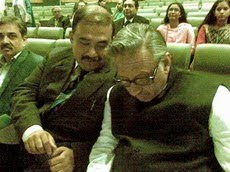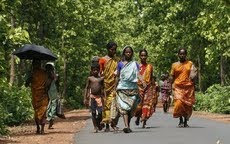 But why would Lalgarh be so important to be Maoists, as much as to equate with Naxalbari. Naxalbari was the site of India's first peasent uprising inspired by Mao Zedong Thought, an uprising that started the process of an armed Maoist movement that spread across India like wildfire. Though Naxalbari is now inhabited by struggling tea workers and smugglers trading in contraband with neighbouring Nepal, it still inspires all those who believe in a Maoist revolution in India.
But why would Lalgarh be so important to be Maoists, as much as to equate with Naxalbari. Naxalbari was the site of India's first peasent uprising inspired by Mao Zedong Thought, an uprising that started the process of an armed Maoist movement that spread across India like wildfire. Though Naxalbari is now inhabited by struggling tea workers and smugglers trading in contraband with neighbouring Nepal, it still inspires all those who believe in a Maoist revolution in India. The only thing that is common between Naxalbari and Lalgarh is that both have predominantly tribal populations who are alienated and have not benefitted from the land reforms of the Marxist government. The tribals in Bengal’s Junglemahal area (in which Lalgarh falls) have been completely alienated because in the last 30 years, they have got nothing from the Communist coalition government here. The Communist rulers have taken the tribals for granted. The Indian Left, specially the CPI and the CPI(M) had never understood the tribes , the power of ethnicity. Not withstanding the 1973 Prakash Karat thesis on "Language and Nationality Politics in India", perhaps written as a student leader in Jawaharlal Nehru University. The Maoists have been different. Slowly but steadily since the crushing of the first Naxalite movement, the Maoists have clawed their way back as an effective political force by playing on tribal anger across India's huge tribal heartland in central India. Today they are a powerful force in the entire Chotanagpur plateau where much of India's mineral wealth is located. I saw this process start when I visited Bastar in 1982 as a cub reporter. I did write a piece "Red Star over Bastar" which was syndicated in dozens of newpapers by Richa Features run by the late Janardhan Thakur.
The only thing that is common between Naxalbari and Lalgarh is that both have predominantly tribal populations who are alienated and have not benefitted from the land reforms of the Marxist government. The tribals in Bengal’s Junglemahal area (in which Lalgarh falls) have been completely alienated because in the last 30 years, they have got nothing from the Communist coalition government here. The Communist rulers have taken the tribals for granted. The Indian Left, specially the CPI and the CPI(M) had never understood the tribes , the power of ethnicity. Not withstanding the 1973 Prakash Karat thesis on "Language and Nationality Politics in India", perhaps written as a student leader in Jawaharlal Nehru University. The Maoists have been different. Slowly but steadily since the crushing of the first Naxalite movement, the Maoists have clawed their way back as an effective political force by playing on tribal anger across India's huge tribal heartland in central India. Today they are a powerful force in the entire Chotanagpur plateau where much of India's mineral wealth is located. I saw this process start when I visited Bastar in 1982 as a cub reporter. I did write a piece "Red Star over Bastar" which was syndicated in dozens of newpapers by Richa Features run by the late Janardhan Thakur. Maoist leader Kishenji claimed in a BBC interview that the mass movement in Lalgarh against “oppression of the establishment Left and its police” has given them a major base in West Bengal for the first time since the Naxalite uprising was crushed in the mid-1970s. We have 1,100 villages with us in the movement. The resistance they have offered in the face of massive state-led coercion has given us much hope, as did the mass boycott of the parliament polls in the area,” he said. “For the first time since the Naxalite movement, we have struck a place which is the weakest spot of the state and which automatically makes it our stronghold.” That is why the Maoists - who have already established their influence in eastern and central India - were keen to hold on to Lalgarh as their “first major guerrilla zone” in Bengal. “It was not a liberated area, as has been wrongly referred by the media. But it was surely emerging as an effective guerrilla zone, where we could undermine if not fully drive away the state,” says Kishenji (real name : Koteswara Rao, a former Calcutta Tramways employee).
Maoist leader Kishenji claimed in a BBC interview that the mass movement in Lalgarh against “oppression of the establishment Left and its police” has given them a major base in West Bengal for the first time since the Naxalite uprising was crushed in the mid-1970s. We have 1,100 villages with us in the movement. The resistance they have offered in the face of massive state-led coercion has given us much hope, as did the mass boycott of the parliament polls in the area,” he said. “For the first time since the Naxalite movement, we have struck a place which is the weakest spot of the state and which automatically makes it our stronghold.” That is why the Maoists - who have already established their influence in eastern and central India - were keen to hold on to Lalgarh as their “first major guerrilla zone” in Bengal. “It was not a liberated area, as has been wrongly referred by the media. But it was surely emerging as an effective guerrilla zone, where we could undermine if not fully drive away the state,” says Kishenji (real name : Koteswara Rao, a former Calcutta Tramways employee). If Lalgarh was secured as a base, the Maoists could then spread their influence elsewhere in Bengal. Lalgarh is important for the Maoists because they are now keen to regain their influence in West Bengal. They were already getting some sympathy from a section of the intelligentsia that is disillusioned with the ruling left after police excesses in the land rights movement in Nandigram. Besides, they could also penetrate the disgruntled industrial workers unions which were upset with the Left’s support for capitalism. Winning over the Bengali middle class through the intelligentsia and the industrial workers are key elements in the new mass line that the Maoists adopted in their last party congress. Kishenji has said that by the time of the 2011 Bengal state assembly polls, they will have a major presence in Kolkata. So Lalgarh for the Maoists is a halfway house to the big city.
If Lalgarh was secured as a base, the Maoists could then spread their influence elsewhere in Bengal. Lalgarh is important for the Maoists because they are now keen to regain their influence in West Bengal. They were already getting some sympathy from a section of the intelligentsia that is disillusioned with the ruling left after police excesses in the land rights movement in Nandigram. Besides, they could also penetrate the disgruntled industrial workers unions which were upset with the Left’s support for capitalism. Winning over the Bengali middle class through the intelligentsia and the industrial workers are key elements in the new mass line that the Maoists adopted in their last party congress. Kishenji has said that by the time of the 2011 Bengal state assembly polls, they will have a major presence in Kolkata. So Lalgarh for the Maoists is a halfway house to the big city.But some feel the Maoists overplayed their cards by striking at security forces and CPI(M) activists in Lalgarh in May end. When the police was thrown out, alarm bells rang in Kolkata and Delhi. That set the stage for the massive security operation to recover Lalgarh and reaffirm administrative control there. Since the Maoists have now been projected as the number one security threat for India by prime minister Manmohan Singh, the new Congress led government could ill afford the brazen takeover of Lalgarh by the Maoists. Regardless of their angst with Bengal's ruling Left.
■ Photos : AFP, Reuters, Naxal-Watch and Arpan Mukherjee
-
(Subir Bhaumik is the BBC's East India Correspondent)







